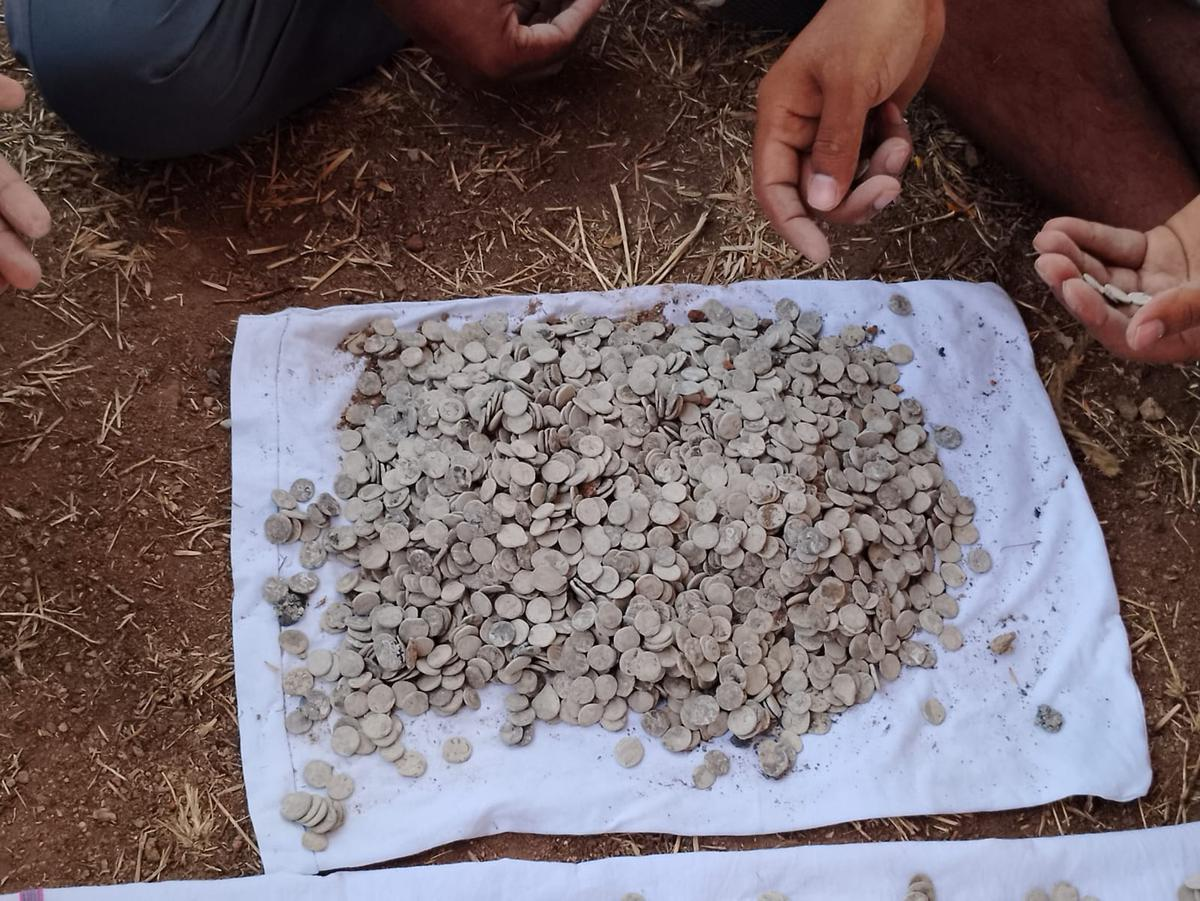Important Facts For Prelims
Ikshvaku Period Coins Found in Telangana
- 25 Apr 2024
- 7 min read
Why in News?
Recently, Telangana’s Department of Heritage discovered a hoard of 3,730 lead coins in an earthen pot at Phanigiri, a renowned Buddhist heritage site located 110 km away from Hyderabad.
What are the Findings of the Excavation?
- Recent Excavation:
- A globular pot measuring 16.7 cm in diameter and 15 cm in height was unearthed at a depth of 40 cm from the ground level in the Southernmost monastic cell.
- The pot's mouth was covered with a shallow pot on the outside and a broken bowl base on the inside and contained 3730 coins weighing an average of 2.3 grams each.
- Archaeologists conclude that all coins, similar in appearance and made of lead, featuring an elephant symbol on the obverse and Ujjain symbol on the reverse, belong to the Ikshvaku period (3rd-4th century CE) based on strata graphical and typological studies.
- Other Artefacts Found:
- Many other valuable cultural antiquities and structural remains, including beads of stone and glass, shell bangle fragments, stucco motifs, broken limestone sculptures, toy cartwheels, iron nails, and pottery, were also unearthed during the excavation.
- Earlier Excavation:
- Excavations at Phanigiri have been conducted on seven separate occasions in the past.
- These excavations at Phanigiri brought to light a Mahastupa, apsidal Chaitya Grihas, Votive stupas, pillared congregation halls, Viharas, platforms with staircases at various levels, octagonal stupa chaitya.
- A 24-pillared mandapa, a circular chaitya, and cultural materials including terracotta beads, semi-precious beads, iron objects, shell bangle pieces, coins, stucco figures, Brahmi label inscriptions, and a holy relic casket were also found.
- Excavations at Phanigiri have been conducted on seven separate occasions in the past.
- Significance of Phanigiri Village:
- Phanigiri village lies on the left bank of the Bikkeru Rivulet, a tributary of the river Musi in Hyderabad.
- It is one of the important Buddhist monasteries strategically located on the hilltop, on the ancient trade route (Dakshinapatha) connecting north to south.
- Etymologically, the village Phanigiri has derived its name from the shape of a hillock located on the northern side of the village, which is like a snake hood.
- In Sanskrit, Phani means snake and Giri means hillock.
- This village was occupied by pre/proto-historic, early historic, early medieval, and Asaf Jahi period (1724-1948) inhabitants.
- This village had a vibrant life from 1000 BCE to late 18th century CE.
- This evolved Buddhist monastery surpasses the monasteries at Amaravathi and Vijayapuri (Nagarjunakonda) in Andhra Pradesh.
- The early historic site at Phanigiri was first discovered and protected during the period of Nizam and was excavated from 1941 to 1944 by Sri Khaja Mahamad Ahmad.
- Other Buddhist Sites in the Region:
- There are several Buddhist sites near Phanigiri, such as Vardhamanukota, Gajula Banda, Tirumalagiri, Nagaram, Singaram, Aravapalli, Ayyavaripalli, Arlagaddagudem and Yeleswaram.
Stratigraphical and Typological Studies of Coins
These are methods used in numismatics (the study of coins) to understand the chronological and cultural context of coins.
- Stratigraphical Studies:
- This method involves studying the layer or strata in which coins are found during archaeological excavations.
- By analysing the stratigraphy, researchers can determine the relative age of coins compared to other artefacts found in the same layer.
- This helps establish a chronological sequence of coinage and understand the history of a site.
- Typological Studies:
- Typology is the classification of coins based on their physical characteristics, such as design, metal composition, size, and inscriptions.
- By comparing these features, numismatists can group coins into types and subtypes.
- Typological studies help in identifying the origin, minting authority, and period of circulation of coins.
What are the Key Facts About the Ikshvaku Period?
- About:
-
The Ikshvakus emerged in the Krishna-Guntur region following the decline of Satavahana power in the eastern part of the peninsula.
-
The Ikshvaku dynasty (300 CE- 400 CE), is named after the legendary King Ikshvaku.
-
-
Knowledge of the Ikshvakus comes primarily from inscriptions, coinage, and archaeological excavations.
-
Evidence suggests that the dynasty emerged in the Vijayapuri region (modern Bellary district, Karnataka) around the 3rd century CE.
-
The Ikshvakus were succeeded by Pallavas.
-
-
- Expansion and Consolidation:
- The Ikshvakus rose to prominence under King Kanha, who significantly expanded their territory.
- Kanha's conquests encompassed parts of Andhra Pradesh, Telangana, and Maharashtra, establishing a formidable regional power.
- Cultural and Economic Contributions:
- The dynasty actively patronised Buddhism, leading to the construction of magnificent stupas and monasteries, like those at Kanaganahalli and Sankaram.
- Ikshvaku coins, featuring Buddhist symbols and regional deities, were widely circulated during this era.
UPSC Civil Services Examination, Previous Year Questions (PYQs)
Prelims:
Q. With reference to the history of India, the terms “kulyavapa” and “dronavapa” denote (2020)
(a) measurement of land
(b) coins of different monetary value
(c) classification of urban land
(d) religious rituals
Ans: (a)
Q. In medieval India, the term “Fanam” referred to:
(a) Clothing
(b) Coins
(c) Ornaments
(d) Weapons
Ans: (b)
Mains:
Q. How do you justify the view that the level of excellence of the Gupta numismatic art is not at all noticeable in later times? (2017)





